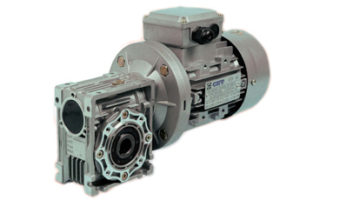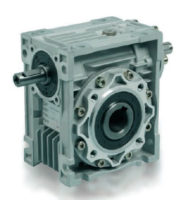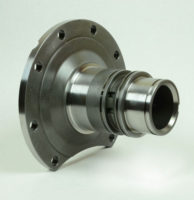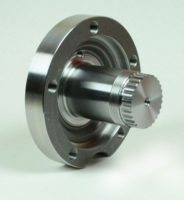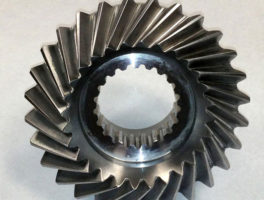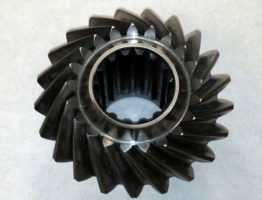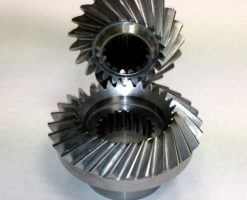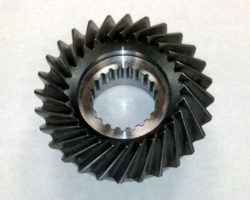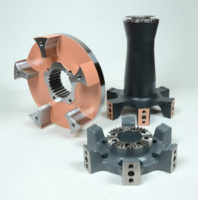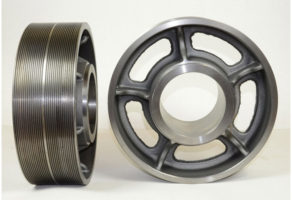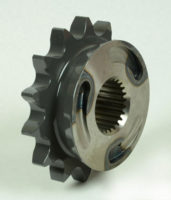
CHIARAVALLI GROUP
BRAND
GIFLEX
®
SERIES GE-T
with FLEXIBLE SPIDER
4
INTRODUCTION
Flexible torsion couplings, which are connecting devices
between rotating shafts, are designed to ensure shock-free
torque transmission and to compensate minor alignment
deviations in operation between the shafts in industrial use.
The GE-T range of flexible couplings ensures this level of
performance and also provides excellent quality thanks to
the machining accuracy and the choice of materials used.
The general level of reliability provided by the
GE-T
cou-
plings is ensured by a satisfactory useful working life of the
couplings.
GENERAL
The
GE-T
range of flexible couplings represents torsional-
ly flexible mechanical couplings capable of transmitting a
twisting moment proportional to the flexible yield of the
中间组件。联轴器必须卡帕ble
of effectively absorbing possible torsional vibrations due to
the load or self-induced, to attenuate impacts and torque
peaks during the start-up phase and to compensate minor
angular and parallel misalignments between the shafts,
however ensuring an acceptable useful working life.
These features and more in general the performance re-
quired from the coupling depend almost exclusively on the
quality intermediate component.
The choice of the material used to manufacture the cou-
pling is therefore fundamental. The curve that expresses the
flexible characteristic of the intermediate component must
have a progressive trend (yielding at low torque values and
remaining rigid at higher torque values) to ensure operation
without jerks at start-up and with a limited torsional yield at
稳态条件。
It is essential for the intermediate component to have a cer-
tain flexible hysteresis, proportional to the required absor-
bing effect that ensures the coupling can efficiently absorb
possible torsional oscillations.
Furthermore, the useful working life of the coupling depen-
ds on the flexible yield of the material comprising the inter-
mediary component. The physical characteristics has descri-
bed above are frequently in contrast with each other and
compared with other basic mechanical and technological
parameters. The performance of the intermediary compo-
nent therefore cannot be adapted to the variety of opera-
ting conditions when only one type of material is used and
therefore the materials adopted for the flexible ring gear
must be differentiated.
A selected thermoplastic elastomer is selected to meet me-
dium level needs in the basic execution.
This refers to an elastomer with medium rigidity, characteri-
sed by an optimum internal dampening effect, resistant to
ageing, to fatigue, to abrasion, as well as hydrolysis and to
the principle chemical agents with special reference to oils
and ozone. Operating temperatures lying between -40 °C
and + 125 °C with brief peaks of up to 150 ° C are permitted
in the case of couplings in the base execution.
Alternative mixes capable of meeting every practical need
have been designed and are available on request for use in
extremely demanding operating conditions , or for needs
that exceed average requirements.
OPERATING AND ASSEMBLY CONDITIONS
Operation of the flexible torsion couplings, such as the
GE-T
type
or similar couplings is characterized by a proportional feature
between the twisting torque and the torsion angle and by the abili-
ty to compensate limited angular and radial misalignments.
Key features of equal importance, but which are more difficult to
interpret are represented by the absorbing factor and natural fre-
quency or resonance.
To qualify its couplings, Chiaravalli Trasmissioni SpA declares per-
mitted twisting torque values correlated to well defined torsion an-
gle values, which has the limiting value of 5 ° C corresponding to
the maximum torque value.
This provides a valid guide for the progressive characteristic of the
flexible curve.
The maximum permitted values are shown in the case of the angu-
lar and radial misalignments, with the warning that these refer to
extreme values that cannot be added together (only angular com-
pensation or only radial compensation) and apply to standard ope-
rating conditions characterised by the following: operating torque
not exceeding the nominal torque, a rotating speed of less than
1,450 r.p.m and coupling temperature not exceeding 40° C.
The maximum rotating speed expressed in r.p.m that corresponds
to maximum peripheral speed of 30 m/sec. is indicated for each
coupling of the
GE-T
range.
This speed can be achieved with a sufficient safety margin compa-
red to the danger of failure due to centrifugal force stress thanks to
the characteristics of the material used.
Class G 2.5 dynamic balancing in compliance with ISO 1940 is re-
commended despite the fact that the half-couplings are fully ma-
chined on both external surfaces, if the actual operating speed
exceeds 2.800 r.p.m
GIFLEX®
GE-T COUPLINGS with FLEXIBLE SPIDER
ACCURATE EXECUTION





